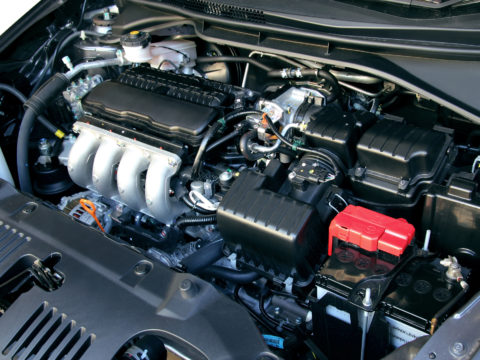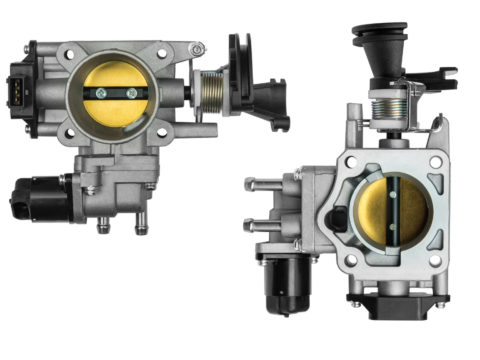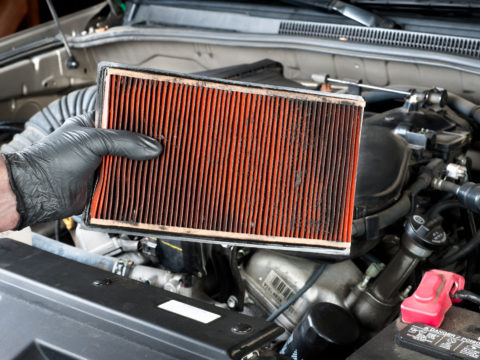A car makes routine internal maintenance checks and transmits that information to the dashboard. If you see a check engine light, your car may be experiencing difficulties. While dashboard lights can be nerve-wracking, they don’t have to be.
Let’s discuss the purpose of the notification, probable causes, how to diagnose it, and how to fix it. We’ll also answer other frequently asked questions.
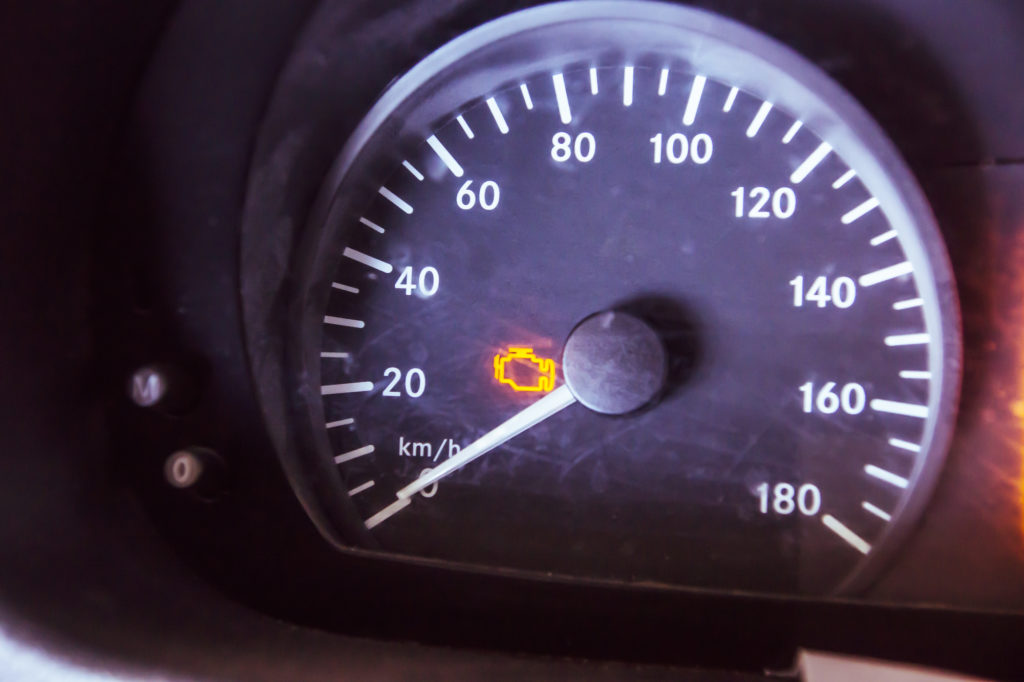
Contents
The Check Engine Light
The function of the check engine light (CEL) is to notify the driver when the car is experiencing a minor or severe engine-related malfunction. While the vehicle’s status is ideal, the light is off and difficult to notice. When a malfunction occurs, you will normally hear a tone and the light will come on. The icon either illuminates steadily, intermittently, or flashes.
The CEL is next to the other vehicle notifications on your dashboard behind the steering wheel. It typically features a picture of an engine, but some models include text such as “Check Engine,” “Service,” or “Maintenance Required.” The light is often red or dark yellow.
The severity of the issue is indicated by the light’s flash rate. A steady light that doesn’t blink indicates a minor malfunction. These do not typically require immediate attention. An intermittent light that only shines for a while indicates a soft failure. A soft error is a momentary lapse in function and is usually resolved with time.
A flashing check engine light, however, is more severe. Your car will not be at risk of explosion or combustion, but a blinking light suggests that your engine has misfired. Misfires can cause expensive damage to your car’s components, so if you see a blinking light, visit a mechanic as early as possible.
Can You Drive a Car With a Flashing CEL?
Steady and intermittent light patterns won’t affect your car’s performance very much. The check engine light will not debilitate your car, but if the issue is severe, you may experience performance issues. A flashing CEL is a high-priority alarm, and it is prudent to visit a mechanic as soon as the problem arises.
While a blinking CEL does not indicate an issue that will make your car unable to run, you shouldn’t ignore the problem. The light is evidence that your car is experiencing an engine misfire, which can result in heavy internal damage.
During a misfire, your car’s exhaust system is stopped up by unburned fuel. The blockage increases internal temperatures and can damage a part called a catalytic converter which helps filter pollutants. Not only is the repair cost expensive, but your car could release unfiltered carbon emissions into the air. It’s always best to seek a mechanic and avoid this outcome.
Why Is My Check Engine Light Flashing?
A check engine notification is not always straightforward. There could be a handful of different causes, including:
- A faulty or loose gas cap
- An electrical error
- A sensitive gauge or sensor
- An engine misfire
- Routine maintenance
There are over a thousand different, distinct error codes that OBD scanners can read, but most of them are broadly described by an issue listed above. Indicators vary a lot by make and model, but here is a short list of what different light configurations mean.
The CEL Flashes Briefly and Then Stops
A brief flash is caused by a few different incidents. One is a sensitive electrical sensor. If your car has a sensitive indicator, you will likely see this notification shine briefly again. If it doesn’t happen again, your car may have experienced a momentary misfire. Sometimes, brief flashing indicates a fuel delivery system sensor error or ignition problem.
A flashing light is serious, even if it only appears briefly. A technician will let you know if this alert needs to be addressed and how best to fix it.
The CEL Flashes Briefly and Then Turns Into a Solid Light
A solid light is always an indicator of a mild problem. If your check engine light flashes briefly before coming solid, your car is likely experiencing a minor issue in addition to an electrical error or sensor malfunction. The car registered a severe error incorrectly before determining there was a minor problem instead.
Regardless, a blinking light means that you should take your vehicle to a mechanic to prevent serious issues. They can also fix the sensitive gauges to prevent future false alarms.
The CEL Flashes Before Starting the Car
Sometimes, the check engine light will come on during ignition before the motor kicks to life. When this happens, it usually means that a component of your car’s ignition system is faulty. The spark plugs and wiring used in the startup system corrode over time. A blinking CEL may indicate this issue.
The CEL Flashes, and the Car Is Shaking
Many internal issues can make a car shake, including faulty spark plugs, engine misfire, and poor fuel pressure. The latter problems can cause lasting, expensive damage to your engine, so you should see a technician as early as possible if you are experiencing shaking or vibration in your vehicle.
A vibrating car tends to indicate the latent effects of an engine misfire. This is a stage you want to avoid at all costs since it most certainly indicates high repair bills.
The CEL Flashes When the Key Is in the on Position
If the check engine light blinks as you turn the key in the ignition, it means that you probably turned the key to ‘start’ instead of ‘run.’ It may also blink like this if your battery is disconnected or if you recently replaced the battery. The light typically blinks for a standard amount of times, often five flashes. It cuts off after those five flashes and isn’t usually cause for concern.
The CEL Flashes During Hard Acceleration
If the light flashes during acceleration, there are a few probable causes. One is a cylinder misfire, which can be serious. If you experience this issue while accelerating, slow down and navigate to a mechanic as early as possible.
A faulty oxygen sensor can also inhibit acceleration and cause a flashing light. It may also mean your car’s catalytic converter is failing. Oxygen sensor issues are relatively harmless and easy to fix, but a catalytic converter problem is serious.
The CEL Flashes, But the Car Runs Fine
While a car with a flashing CEL may appear to run fine, the light only blinks continuously if an issue is serious. Your car could be suffering from a misfire, which can result in exhaust buildup, unburnt fuel, damaged cylinders, and higher emissions. While your car will not break down or explode, it could sustain long-term, expensive damage.
Even if your car runs smoothly, your main priority with a flashing CEL should be to navigate to a service shop before the situation gets worse.
Symptoms of Engine Misfire
An engine misfire is the most critical problem that a flashing check engine light can indicate. If the issue isn’t dealt with, it can cause permanent damage to your vehicle, incurring large repair costs. A misfire can damage both engine and exhaust components such as cylinders and the catalytic converter.
What is an engine misfire? It begins when one or several of the cylinders in your engine aren’t supplied with the power they need. They stutter or stop, resulting in vehicle shaking, acceleration difficulties, and more. When part of the engine isn’t working as intended, unburned fuel can be passed through to the exhaust system, which damages components there.
There are many causes for the cylinder’s power failure. A bad or rusted spark plug will fail to supply the right amount of power to the engine. A faulty fuel injector will do the same by limiting the fuel the engine can use.
Cars also have an internal oxygen sensor that measures the amount of oxygen in the exhaust. When they sense irregularities, they limit the oxygen in the combustion chambers of the engine. A faulty oxygen sensor can also cause a misfire in this way.
The expenses misfires incur can be hefty. Your car may fail to start or run properly if you ignore the issue, so make sure to visit a mechanic if your car experiences any of the following symptoms:
- Vibrating or shaking
- Knocking
- Acceleration hiccups
- Decreased performance
- Stalling or lagging ignition
- Dark fumes from the exhaust pipe
- Overheating
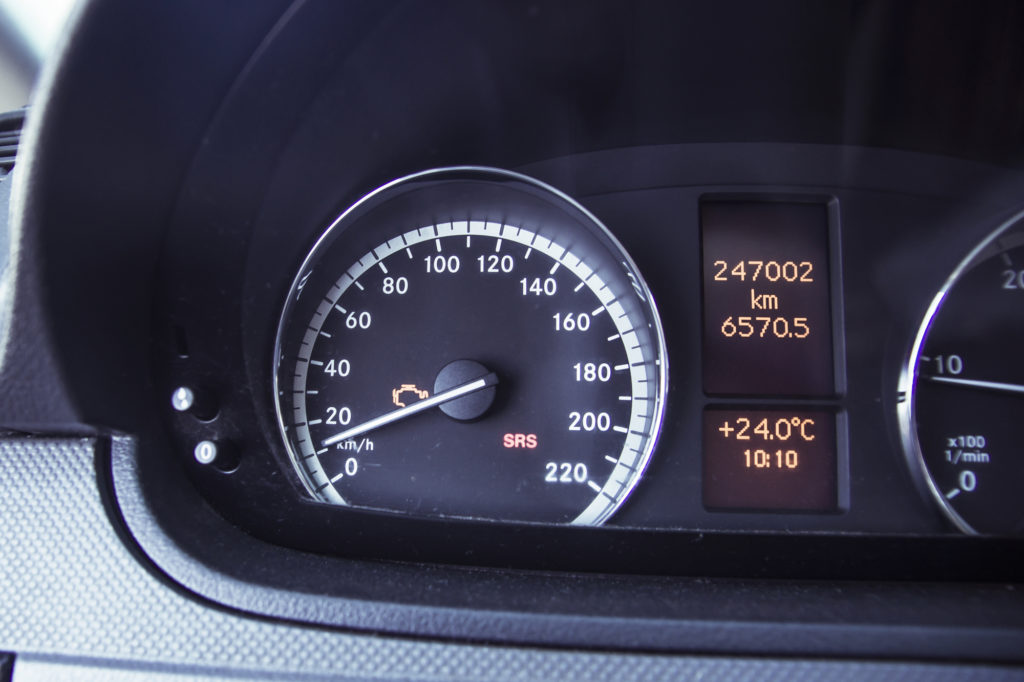
How Do I Diagnose a Flashing Check Engine Light?
A flashing CEL is not merely a notification alerting that something is wrong. A computer inside every car stores an error code pointing to the specific problem your car is experiencing. These are called on-board diagnostics (OBD) codes, and each car manufacturer tends to have a specialized series of codes.
Modern OBD codes can only be read with scanning devices that interpret the data directly from cars. They typically connect to the car directly via a port near the steering column. While these machines aren’t perfect, they are a fairly reliable source of diagnostic information for your car’s issue.
There are a wide variety of codes that an OBD scanner can interpret. Regarding flashing check engine lights, you may encounter the codes listed below.
- Codes P0300–P0312 indicate misfires in one or several cylinders.
- P0420 indicates that the catalytic converter is operating below standard efficiency.
- Codes P0440–P0455 suggest emission control leakages.
A popular model of this tool is the AutoZone Innova scanner, which can interpret and transmit this data across almost every car model since 1996, when the OBD2 system was implemented. It plugs into a specialized port near the steering wheel.
Turn on the ignition without starting the engine, wait five seconds, and then plug in the device. The scanner will connect with the car’s computer and read its diagnostic data. Once you have the error code, write it down and bring the information to a certified technician or mechanic. They will help you assess the gravity of the issue and suggest costs and fixes.
How To Fix Flashing Check Engine Light
When the light first comes on, you will likely hear a tone. If it’s safe to do so, observe the status of the light.
If it’s steady, there’s no immediate cause for alarm. A steady light can be triggered by a few easy-to-fix things. Stop the car and try to adjust the gas cap. If it isn’t completely screwed in, correct its position. Otherwise, try turning the car off, waiting a moment, and powering it back on. If your situation doesn’t change, visit a mechanic whenever it is convenient.
If the light is flashing, observe it for a moment to determine whether it stops. If it doesn’t stop, head to a technician as soon as possible to prevent lasting damages. The technician will be able to diagnose your car’s specific problem and propose a solution. Drive slowly and do not accelerate dangerously. Straining your car’s capabilities could cause more breaks.
If the light doesn’t stop, your car isn’t experiencing additional symptoms, and you think an engine misfire is doubtful, your light may be faulty. Electrical components sometimes malfunction, which is why a failsafe like the CEL reset exists.
You can reset your check engine light in a few different ways. One way is to stop your car, lift the hood, disconnect the negative side of your car battery, and wait a few minutes. Then, reconnect the negative, and the indicator should be reset. You may also press the horn or headlight switch while the negative is disconnected to rid the car of any stored energy.
Keep in mind that this does not make the light go away if your car has a legitimate issue. The car’s sensor will inevitably read the issue again and relight the notification.
In the worst case of an engine misfire, you will likely see costs ranging between $100 and $3,000, not factoring in the service cost of the mechanic. Engine components are more expensive, while electrical components like spark plugs are relatively cheap to fix. However, ignoring a misfire is bound to result in damaged engine and exhaust components, which are expensive.
It’s important to be careful and not overestimate the durability or resilience of your vehicle. It’s also critical not to misjudge the check engine light as an inconvenience rather than an alarm. While many mechanisms can falsely illuminate it, you don’t want to risk the worst-case scenario and incur needless expenditures.
Frequently Asked Questions
While a flashing CEL doesn’t have to be nerve-wracking, it can still produce a lot of questions. Here are some of the most frequently asked questions regarding flashing check engine lights.
How serious is a flashing check engine light?
Out of all of the configurations of the CEL, a consistent flashing light is the most serious. It could indicate a problem that causes permanent damage and requires expensive repairs. Faulty electrical components could mean that it isn’t serious, but I would not advise taking a risk by neglecting it.
How long can you drive with a flashing CEL? (before you can get it to a service shop)
Your car will be fine for a long time. It will only suffer driving impediments like vibrating, knocking, or stalling if the problem grows dire. Still, you should make it a priority to visit an auto technician to prevent severe symptoms.
Why is my check engine light on and cruise control flashing?
In some car models, the cruise control light flashes instead of the check engine light. This is usually to let the driver know that cruise control is disabled while the problem persists. The check engine light will always be on alongside this notification. Take your car to a mechanic as soon as possible for an assessment.
Where can you get a free diagnostic for your car?
Many auto parts stores and other retailers offer free scans and diagnostics. AutoZone is one of a few choices that permit a free fix-finder test. They will lend you an OBD scanner that will retrieve diagnostic data from your car to determine the issue. Then, you can elect to either fix the problem yourself or enlist the help of a technician.
How much does it cost to repair an engine misfire?
Depending on the cause, the standard price ranges from $100–$3,000. This estimate doesn’t include mechanic fees. Electrical causes like bad spark plugs are cheap to repair, but parts like engine cylinders and catalytic converters can be expensive to replace.

